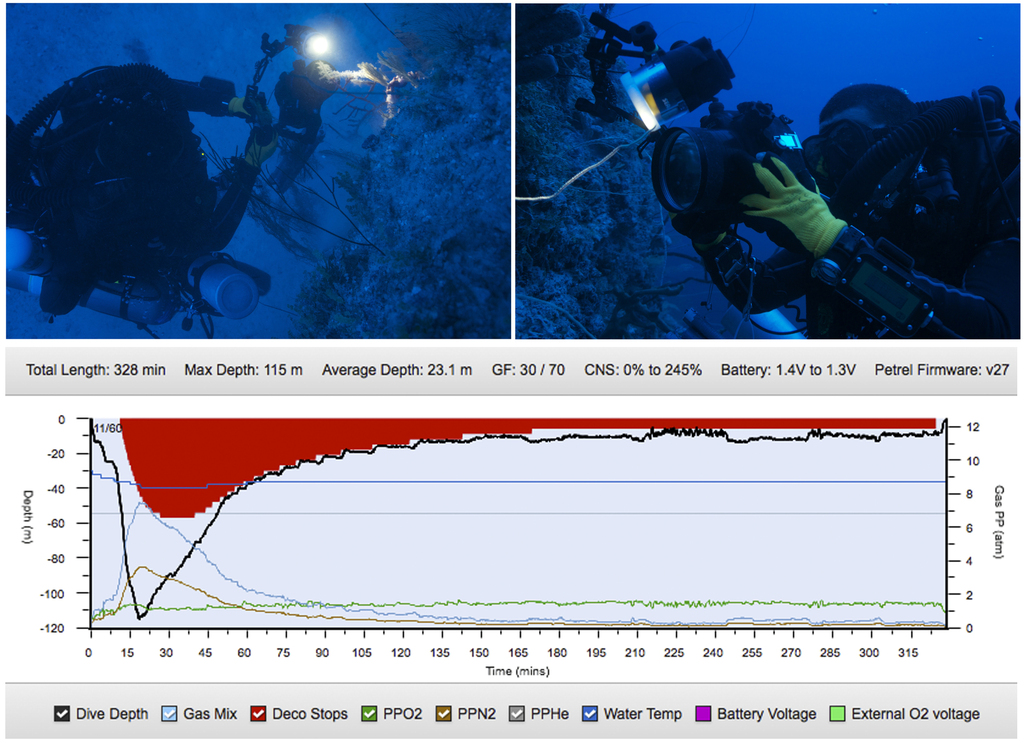Behind the science:
Holobiont Diversity in a Reef-Building Coral over Its Entire Depth ...
2018, June 6
Posted by Veronica Radice
“Coral holobiont diversity over its depth range in the mesophotic zone”
What was the most challenging aspect of your study (can be anything from field, lab to analysis)?
Sampling down to 100 m (330 ft) was the first challenge we encountered. Particularly in the Deep-sea corals national park, which is off-shore with strong currents, logistics for the anchoring and Deco stops were pretty challenging. In contrast, at San Andres island we can reach the same depth diving from shore. Of course the lab components, which included population genomics and metabarcoding analyses, imposed a tough standardization period and steep learning curve as well.
What was the most memorable moment in undertaking this study?
During a long Deco stop hanging from the anchor line bottlenose dolphins showed up and lingered for a while- that was really amazing. From the scientific point of view, we never expected that the coral we were studying, Agaricia undata, was so healthy and abundant at such great depths for a reef building coral. Even more unexpected, everything related to their endosymbionts as shown in the paper.
 Preparing gear for closed circuit rebreather diving
(C) JA Sanchez
[CC BY-NC 4.0]
Preparing gear for closed circuit rebreather diving
(C) JA Sanchez
[CC BY-NC 4.0]
What was your favorite research site in this study and why?
Its got to be Trampa Tortuga in San Andres, a sandy wall with steps at 60, 80, 90 and 115 m with lots of corals and octocorals, very impressive sights and biodiversity. Recently, on the other side of the island we found a “pink garden” another wall starting at 80 m with dense pink octocorals. Everything is so beautiful and colourful in that wall, which starts after a huge sand dune.
Other than your co-authors, with whom would you like to share credit for this work?
Yes several CCR divers that supported us especially Nacor Bolaños, Julio Andrade, Deibis Deguro and Oscar Ruiz. Nacor, from Coralina (the environmental authority at San Andrés, Providencia and Santa Catalina archipelago), was also of incredible help in getting resources and logistics for this pioneering mesophotic research in Colombia. In the Cartagena area, Federico Botero, Helmer Torres and all the staff from the park authority made possible the exploration there. Luisa Dueñas was particularly supportive during field and lab analyses.
 Mesophotic reef shark at Bluewall
(C) J Andrade & JA Sanchez
[CC BY-NC 4.0]
Mesophotic reef shark at Bluewall
(C) J Andrade & JA Sanchez
[CC BY-NC 4.0]
Any important lessons learned (through mistakes, experience or methodological advances)?
Many, for the CCR exploration you have to consider each dive as an expedition. This is not just another dive, the planning has to be extremely detailed and careful. We did not have any incidents and we trained hard in caves in Florida with Gregg Stanton but open ocean deep diving can be strenuous and unpredictable. The CCR equipment in salt water rusts easily and electronics can fail, so preparations and precautions should be extreme. And, get as many samples as you can from each expedition- it is hard go back to the same place!
Can we expect any follow-up on this work?
Yes! We just got a paper accepted in Coral Reefs on the associations of Agaricia undata with endolithic algae, there are some mindblowing results, stay tuned!
 A typical mesophotic dive at San Andres
(C) J Andrade & JA Sanchez
[CC BY-NC 4.0]
A typical mesophotic dive at San Andres
(C) J Andrade & JA Sanchez
[CC BY-NC 4.0]
Featured article:
|
|
Holobiont Diversity in a Reef-Building Coral over Its Entire Depth Range in the Mesophotic Zone | article Gonzalez-Zapata FL, Gonzalez-Zapata FL, Bongaerts P, Ramírez-Portilla C, Adu-Oppong B, Walljasper G, Reyes A, Sanchez JA (2018) Front Mar Sci |

|
